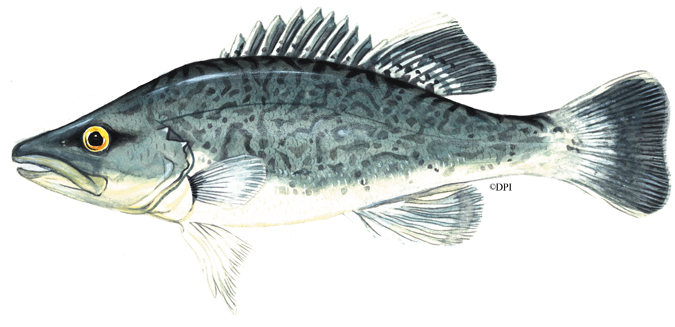Trout cod

| Common Name: | Trout cod |
| Other Name/s: | Bluenose cod |
| Family: | Percichthyidae |
| Scientific Name: | Maccullochella macquariensis (Cuvier, 1829) |
| Origin: | Native |
Conservation Status
State: Classified as "threatened" under the Flora and Fauna Guarantee Act 1988.
Federal: Classified as "endangered" under the Environment Protection and Biodiversity Conservation Act 1999
Description
Broad depressed head with a rounded snout and a straight forehead profile. Larger upper jaw and overhanging lower jaw. Larger eyes than Murray cod. Body colouring can be dark to light brown but generally bluey-grey, with small dark grey to black spots or dashes on the upper body extending on to the lower sides and on the bases of the dorsal, caudal and anal fins.
Fins mainly grey to dark grey, often edged with white. Markings are fewer (if any) on the head, and a dark horizontal stripe usually extends from the nose through the nostril and eye onto the gill cover.
Lateral line follows the upper body profile and extends to the tail. Known to have reached 800 mm in length and 16 kg in weight, but more commonly 400-500 mm and 1.5-3 kg. Largest fish recorded in Victoria was 685 mm and 11 kg.
Distribution
In Victoria, believed to have been once fairly wide spread in north-central and north-eastern streams flowing into the Murray River.
The only known remaining self-sustaining population of trout cod in Victoria is confined to the Seven Creeks system near Euroa.
Distribution has been extended in recent years as suitable waters are identified and fish produced at Snobs Creek Hatchery for stocking these waters in a program aimed at establishing new viable populations. As a result there are now viable populations in several waters including the Goulburn River and the Ovens River..
Habitat
Cooler upper reaches of streams, usually in flowing pools between falls and rapids where the stream bottom is bed-rock, boulders and sand or gravel substrates. Larger fish are usually found in the deeper holes, smaller fish beneath and amongst boulders.
Brief Biology
Trout cod spawn during spring-early summer when water temperatures are about 17-18°C, and are thought to breed at a smaller size than Murray cod. Eggs are adhesive and laid on or near the stream bottom.
Diet includes aquatic insects and crustaceans such as yabbies, crayfish and shrimps. They may also leap from the water to take food items just above the surface.
Management
The Department has been conducting research on trout cod for some years, and is now successfully breeding the species at Snobs Creek Hatchery.
Since 1988 juvenile trout cod have been released into a number of streams which have been identified as potentially suitable habitat for stocking the species in an attempt to establish additional trout cod populations.
Other Notes
Closely related to the Murray cod. Although first described in 1829, it was not until 1972 that it was recognised scientifically as a distinct species from Murray cod.
Apart from environmental changes such as those caused by dams, siltation and "river improvement" activities, it is likely, because of similarities in habitat requirements, certain aspects of observed behaviour (such as establishment of territories), and feeding habits, that introduced trout may have been a factor in the decline in range and abundance of trout cod.
Trout cod settle down well in aquaria and take a variety of natural and artificial foods.
Regulations
Recreational Fishing Licence requirements, and regulations affecting the taking of Trout cod in Victoria, are provided in the Victorian Recreational Fishing Guide, available free from RFL sales agents and DEDJTR Offices and Information Centres.
The taking of trout cod from Victorian waters is prohibited, and the possession of trout cod is permitted only by a permit issued by the Department.
Victoria's principal viable population of trout cod in Seven Creeks is protected by a total closure to fishing of the section of stream between Polly McQuinns Weir near Strathbogie, downstream to the Galls Gap road bridge below Gooram Falls.
Further Reading
- A Guide to the Freshwater Fish of Victoria, Phillip Cadwallader & Gary Backhouse, Department of Conservation and Environment.
- Australian Freshwater Fishes, John R. Merrick & Gunther E. Schmida.
- Biological Information for Management of Native Freshwater Fish in Victoria, J D Koehn, W G O'Connor.
- Flora and Fauna Guarantee Act 1988 - Action Statement No. 38 Trout Cod, Department of Sustainability and Environment.

